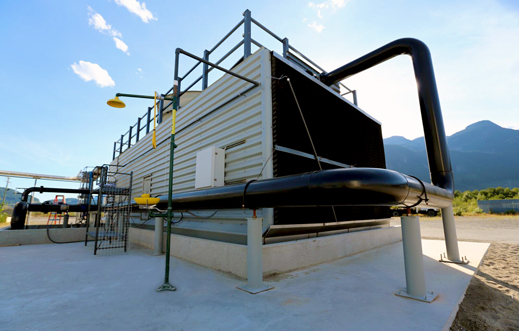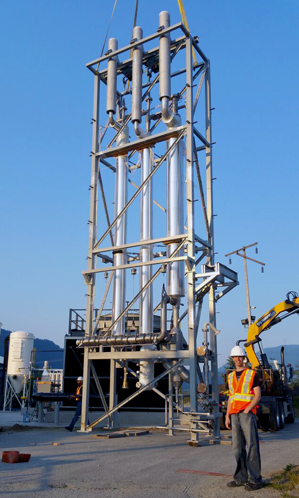| Pilot plant in Canada tries to demonstrate carbon capture on an industrial scale. By Richard Martin on October 9, 2015 Why It MattersDirect-air carbon capture could lead to carbon-neutral transportation fuels.
Carbon Engineering’s air contactor passes ambient air through liquid to produce a carbon dioxide-rich solution. On Friday a group of government officials, environmentalists, and local bigwigs gathered in the coastal town of Squamish, British Columbia, about an hour north of Vancouver, to mark the onset of what could one day be a new industry: creating carbon-neutral transportation fuel made from carbon dioxide captured from air. The company that built the plant, Carbon Engineering, was founded by a Canadian scientist named David Keith. A Harvard professor of applied physics, Keith has made headlines before for his outspoken advocacy for more research into geoengineering (specifically, seeding the lower stratosphere with sulfuric acid to reflect sunlight and cool the planet). With the carbon capture venture, though, Keith is being careful not to overhype his company’s technology: while Carbon Engineering’s process should be able to strip carbon dioxide out of the air at a rate of around one ton per day, Keith emphasizes that it’s not designed for or capable of measurably reducing the greenhouse gases in the atmosphere. Rather, the motivation is to produce fuels for transportation applications, such as jet aircraft and heavy-duty trucks and buses. The process uses a large wall of fans, known as a contactor, to push air through a liquid that reacts with the CO2. That carbon dioxide-rich solution is then put through several processing steps to create a purified stream of CO2 gas and the liquid that is returned to the contactor. Keith and his team have cleverly combined industrial processes that are already in use in existing industries, for instance in paper mills. “This is not new technology,” says Keith. It’s also only half the process needed to actually make fuel. The recovered CO2 must then be combined with hydrogen to make hydrocarbon fuels. Supported by funding from British Columbia’s provincial government, Carbon Engineering plans to install an electrolyzer to split water to obtain hydrogen that it will then use to supply fuel for BC Transit buses. That’s at least a year down the road.
A component is delivered to the pilot plant site in Squamish, British Columbia. The full system is relatively energy-intensive, which means that cheap, low-carbon power generation, most likely from solar power, will eventually be needed to make the energy economics work. Carbon Engineering, which has been funded by a series of investors including Bill Gates, is one of several companies, including the German firm Climeworks, working on carbon capture systems. (Most of them employ systems in which the CO2 is absorbed by a solid, rather than a liquid.) In the past these technologies have been touted as having the potential to significantly reduce the total amount of carbon in the atmosphere, thus slowing down global climate change. For now that’s a pipe dream; for one thing, as with systems that capture carbon from the smokestacks of fossil fuel power plants, it’s simply too expensive for the massive scale-up that would be required. What’s more, the systems require much energy to operate. An active market for fuels made with air-captured CO2 would go a long way toward making the economics work out, at least for small-scale systems. Burning the fuel made in this way would, of course, release carbon, but unlike the combustion of fossil fuels it would not add to the total amount of carbon dioxide in the atmosphere. The cost of producing fuel at the Squamish pilot plant, once it’s fully operational, will be much higher than that of conventional fuels, but Keith says that, once the process is scaled up using solar power, he hopes to produce fuel for $1 a liter. (Jet fuel currently sells for around 37 cents per liter; diesel, for just under $1 per liter.) That could happen in a few years, or it might never happen; but the plant opening in Squamish will begin testing the possibility. “This whole topic has been polarized more than anything else I’ve worked on,” Keith says. “I hope we can move to a world where people treat this like a normal technology. It’s not a silver bullet, but it’s not B.S. either.”
http://www.technologyreview.com/news/542226/test-facility-begins-capturing-carbon-from-air/ |


Nenhum comentário:
Postar um comentário
Observação: somente um membro deste blog pode postar um comentário.